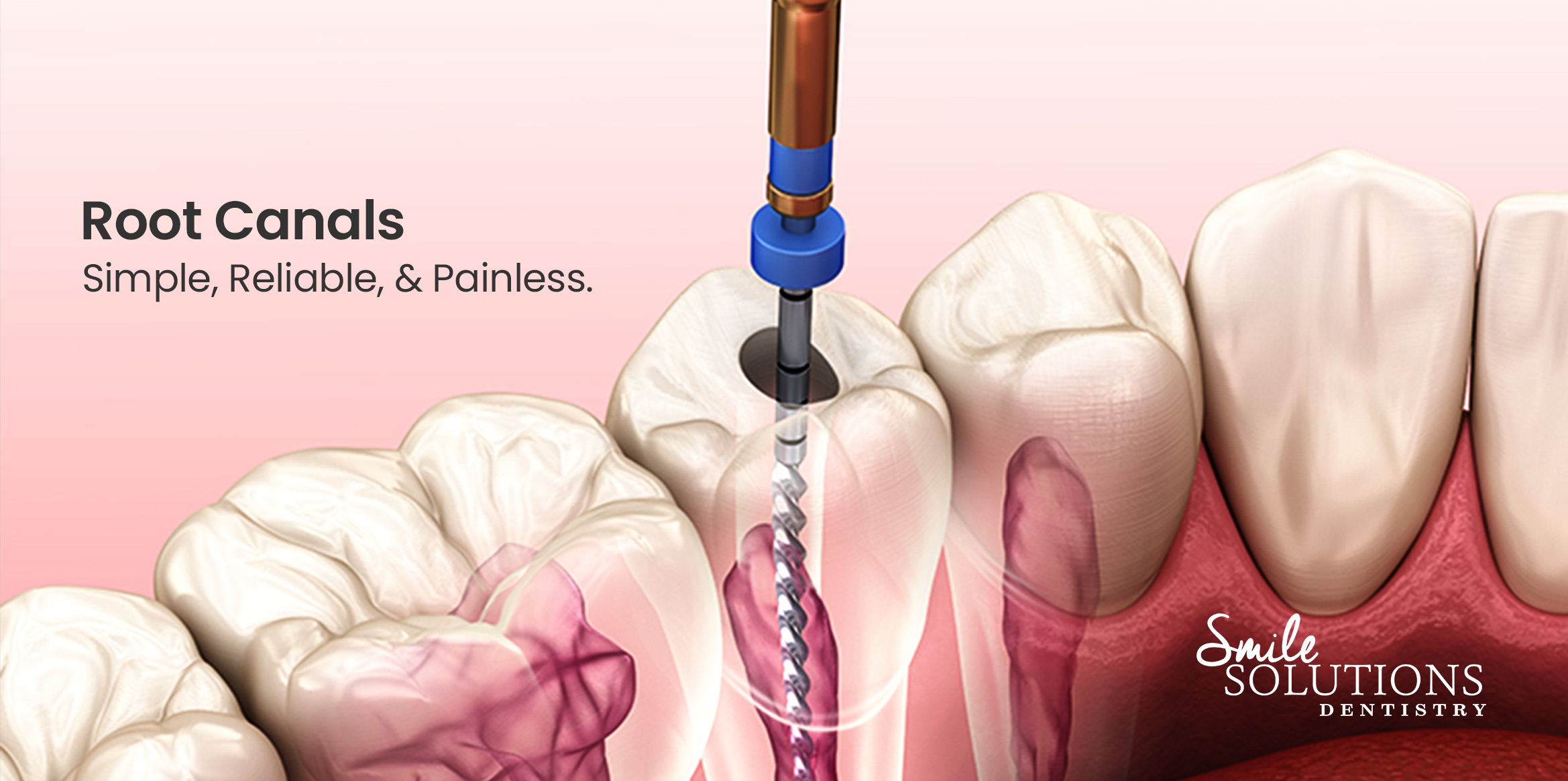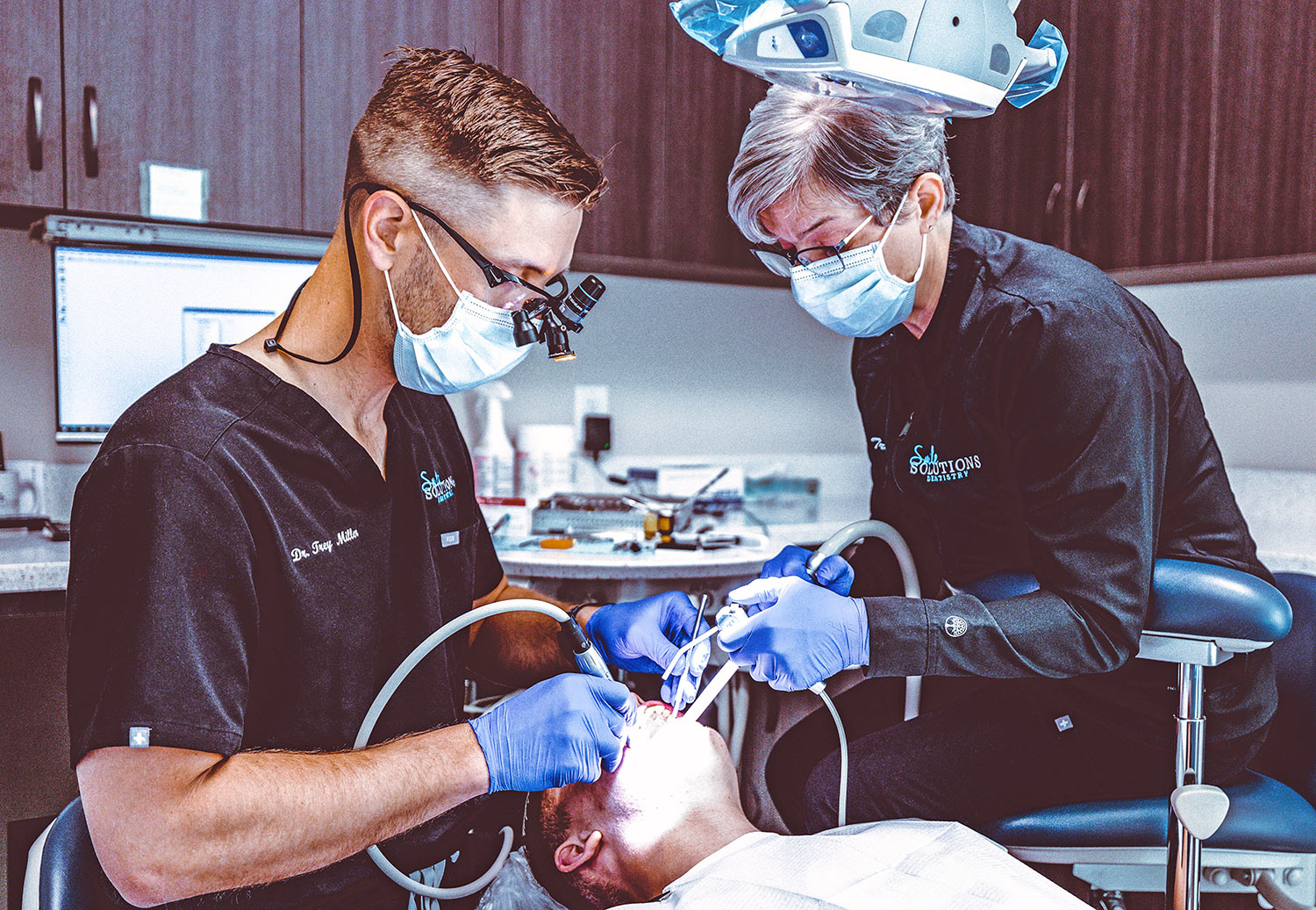Root Canals: Simple, Reliable, & Painless
Mention the word root canal, and people shudder. The procedure has evoked fear for centuries, and for good reason. Medieval procedures—that go as far back as the 3rd century—were anything but humane. Luckily, root canals have come a long way since those experimental days of dentistry.
Root canals are a common procedure at Smile Solutions Dentistry. In fact, we perform them on almost a daily basis. It’s a simple and safe procedure that has a 98% chance of success—saving your tooth from a painful extraction.
Our Simple Root Canal Process
A root canal can seem like a long strenuous process, but they don’t have to be. We do everything we can to make your procedure as quick and relaxing as possible. The following steps are taken when performing a root canal in our office:
Root canals don’t have to be scary.
Step 1
The first step is to numb the area in which the root canal will be performed.
Step 2
The next step involves placing a rubber dam (a non-latex material) over your tooth with the aid of a specialized clamp. This is used for a couple reasons when getting a root canal. a) to ensure a sterile environment keeping all bacteria inside the mouth in and all fluids and cleaning agents out and b) to ensure instruments and tooth debris are not aspirated in a patient’s airway.
Step 3
The third step involves removing all decay (cavity) from the tooth.
Step 4
Next, we find the canals and create straight-lined glide paths (unencumbered pathways for dental files).
Step 5
The end of a canal is found typically with a dental device called an Apex Locator or by using a small dental file and an x-ray. Finding and measuring the distance from the top of your tooth to the “apex” or end is the first step to performing a successful root canal.
Step 6
All nerves, blood supply, and lymphatics are removed from within the nerve canal space (this is one of the most important steps). Complete removal of these items will allow for proper healing of your root canal in the days and weeks to come.
Step 7
Once step 6 has been completed, the canal space, which is an oval and irregularly shaped canal, is formed into a perfect cone. This cone is custom, and the ideal shape and size is determined for your specific tooth and canal by your dental provider.
Step 8
Throughout the procedure the canal space will be irrigated with copious amounts of disinfectant materials such as Sodium Hydroxide, and sometimes Chlorhexidine solutions. These medications will clear unwanted debris inside the canal and medicate the canal space to get rid of all unwanted harmful bacteria.
Step 9
The canal is then dried with “paper points”, which are small, custom-sized paper cones designed to remove fluids from within the root canal space. This will allow for a proper seal at the end of the procedure.
Step 10
Custom Gutta Percha cones are tested specifically for each canal with appropriate “tug back” to ensure an adequate apical seal. Tug back is a feeling of resistance a gutta percha gives when the root canal space has been properly instrumented.
Step 11
An x-ray is taken to confirm the Gutta Percha’s fit.
Step 12
Once all of these steps have been performed, a special sealer is used to coat the Gutta Percha to ensure micro leakage does not occur inside the canal space. This sealer will help aid in the healing process.
Step 13
The coronal excess portion of the Gutta Percha is removed with a heated instrument.
Step 14
Finally, your root canal is complete and a filling is placed over top the Gutta Percha to stabilize the tooth and prevent bacteria from entering the canal space.
Why is a root canal needed?
Root canals are needed when bacteria has infiltrated the “nerve” or root of a tooth. Once this happens, patients are typically uncomfortable and in pain. The only way to correct and treat the infected nerve is to perform a root canal, or to extract the tooth. Antibiotics will temporarily aid in pain relief, but it will not remove the infection from within the nerve.
How long does a root canal procedure take?
At Smile Solutions Dentistry, a root canal procedure can last anywhere from 30 minutes to 1.5 hours. Rarely does the procedure take longer and when it does it is because of unforeseen complications that arise during the procedure. While this is rare, these complications can be due to, but not limited to the following: calcified canals, extra canals, canals that bend at sharp angles, previously fractured roots, excessive amounts of infection, excessive bleeding, etc. Typically these issues are all maintainable and rarely create unmanageable situations.
Why do people say a root canal is painful?
Root canals are not typically painful. If the appropriate steps are followed, the risk of post-operative complications is very low. One reason patients could have discomfort during a procedure is due to anesthesia issues. This is typically due to the way anesthetic agents work in our bodies. Anesthetics are basic chemicals and will neutralize in acidic environments like infections reducing their effectiveness. This can lead to sometimes uncomfortable situations. This is rarely an issue at Smile Solutions Dentistry.
It is normal to be sore for 48-72 hours while your body is healing. Extreme pain is rare, and if it occurs you should seek a dental expert immediately. A few reasons you could be experiencing discomfort after a root canal procedure are:
- Improper irrigation
- Improper gutta percha placement
- Forceful irrigation beyond the apex of a root
- Fracture if a tooth’s root
- An unforeseen extra canal that was not found during the procedure
These are a few of the reasons that root canals could be painful after a procedure. Due to all of these factors, it is important to seek a dental provider that you trust and has a reputation for performing root canal/endodontic procedures with a high success rate.
Are antibiotics needed after a root canal procedure?
Antibiotics are not typically needed after a root canal because the infected tissue has been properly removed from the tooth. Less than 5% of the time an antibiotic is prescribed. Typically this is due to significant signs of infection during the root canal/endodontic procedure.
How long can I expect my root canal procedure to last?
If performed correctly, a root canal should last as long as the tooth remains restorable. A tooth can still get a cavity on it after a root canal has been performed. It is important to practice good oral hygiene to ensure the tooth stays as healthy as possible.
Why is a “crown” needed after a root canal?
After a tooth has had a root canal, a crown or cap may be recommended by your doctor. Typically, posterior teeth (teeth towards the back of your mouth) need to have a crown or cap. You would typically need a crown to help strengthen and protect your tooth from forceful biting forces. After a root canal has been performed, the nerve, blood supply, and nutrients have been deprived of the tooth causing it to be brittle over time without some form of full coverage restoration like a cap or crown. Without a crown, your tooth will eventually break—creating an unwanted extraction scenario.
Conclusion
Root canals don’t have to be scary. Whether it’s your first root canal, or your fifth, we have you covered. Experience the kind of family dentistry you and your loved ones deserve.




